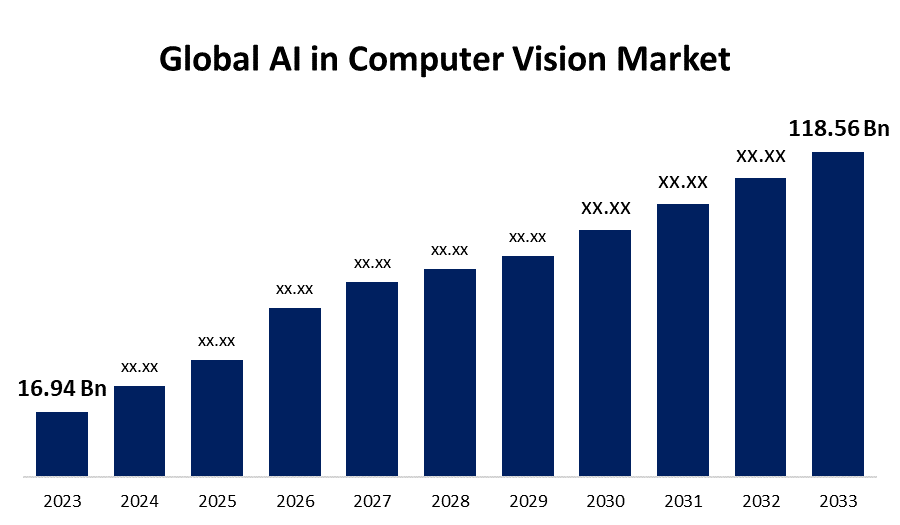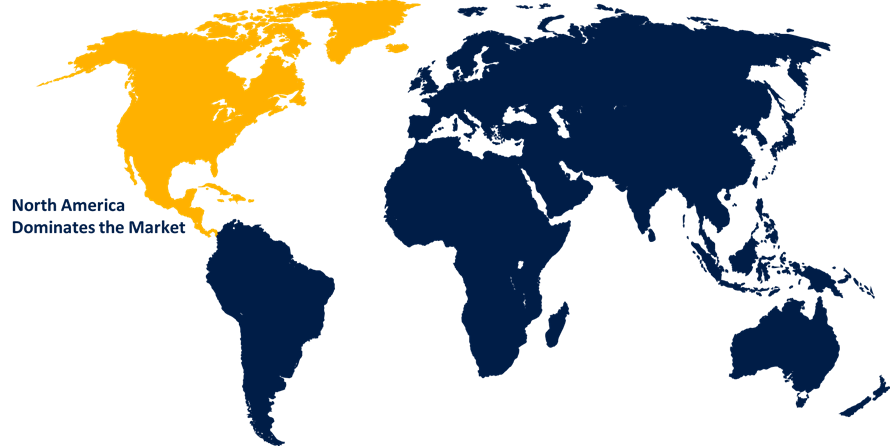Global Artificial Intelligence In Computer Vision Market Size, Share, and COVID-19 Impact Analysis, By Component (Hardware and Software), By Function (Training and Inference), By Application (Industrial and Non-industrial), By End-Use (Automotive, Consumer Electronics, Healthcare, Retail, Security & Surveillance, Manufacturing, Agriculture, Transportation & Logistics, and Others), By Region (North America, Europe, Asia-Pacific, Latin America, Middle East, and Africa), Analysis and Forecast 2023 - 2033
Industry: Information & TechnologyGlobal Artificial Intelligence In Computer Vision Market Insights Forecasts to 2033
- The Global Artificial Intelligence in Computer Vision Market Size was valued at USD 16.94 Billion in 2023.
- The Market is Growing at a CAGR of 21.48% from 2023 to 2033
- The Worldwide Artificial Intelligence in Computer Vision Market Size is expected to reach USD 118.56 Billion by 2033
- Asia-Pacific is Expected to Grow the fastest during the forecast period

Get more details on this report -
The Global Artificial Intelligence in Computer Vision Market Size is Expected to reach USD 118.56 Billion by 2033, at a CAGR of 21.48% during the forecast period 2023 to 2033.
Market Overview
Artificial intelligence has revolutionized the field of computer vision by enhancing the capabilities of machines to interpret and understand visual data. Computer vision with AI enables machines to perceive, analyze, and extract meaningful information from images or videos. Through deep learning algorithms, AI-powered computer vision systems can recognize objects, detect patterns, and perform complex tasks like image classification, object detection, segmentation, and tracking. AI also enables advancements in facial recognition, autonomous vehicles, medical imaging, and augmented reality. By combining neural networks, machine learning, and big data, AI in computer vision has made significant strides in accuracy, speed, and efficiency, enabling applications across various industries, including healthcare, retail, transportation, and security. The continuous evolution of AI algorithms and hardware is further driving the progress of computer vision, unlocking its potential for future innovations.
Report Coverage
This research report categorizes the market for artificial intelligence in computer vision market based on various segments and regions and forecasts revenue growth and analyzes trends in each submarket. The report analyses the key growth drivers, opportunities, and challenges influencing the artificial intelligence in computer vision market. Recent market developments and competitive strategies such as expansion, product launch, and development, partnership, merger, and acquisition have been included to draw the competitive landscape in the market. The report strategically identifies and profiles the key market players and analyses their core competencies in each sub-segments of the artificial intelligence in computer vision market.
Global Artificial Intelligence In Computer Vision Market Report Coverage
| Report Coverage | Details |
|---|---|
| Base Year: | 2023 |
| Market Size in 2023: | USD 16.94 Billion |
| Forecast Period: | 2023-2033 |
| Forecast Period CAGR 2023-2033 : | 21.48% |
| 2033 Value Projection: | USD 118.56 Billion |
| Historical Data for: | 2019-2022 |
| No. of Pages: | 200 |
| Tables, Charts & Figures: | 120 |
| Segments covered: | By Component, By Function, By Application, By End-Use, By Region. |
| Companies covered:: | NVIDIA Corporation, Intel Corporation, Microsoft, IBM Corporation, Qualcomm Technologies Inc., Advanced Micro Devices, Inc., Alphabet, Inc., Amazon, Basler AG, Hailo, Groq, Inc. |
| Pitfalls & Challenges: | COVID-19 Empact, Challenge, Future, Growth, & Analysis |
Get more details on this report -
Driving Factors
The rapid growth of the artificial intelligence in computer Vision market is driven by several key factors. The increasing availability of vast amounts of visual data, coupled with advancements in computing power and storage, has facilitated the development of sophisticated AI algorithms for visual analysis. Additionally, the demand for automation and optimization across industries, such as manufacturing, healthcare, and retail, has fueled the adoption of AI-powered computer vision systems for tasks like quality control, object detection, and inventory management. Furthermore, the advancements in deep learning techniques, including convolutional neural networks and generative adversarial networks, have significantly improved the accuracy and efficiency of computer vision models. Moreover, the integration of AI with other emerging technologies like augmented reality and edge computing has expanded the possibilities and applications of computer vision, creating new opportunities for growth in the market.
Restraining Factors
While the artificial intelligence in computer vision market is experiencing rapid growth, there are also some restraints that need to be considered. The concerns over data privacy and security pose a challenge to the widespread adoption of AI in computer vision, as the processing and analysis of sensitive visual data raise ethical and legal implications. The complexity and computational requirements of AI algorithms can limit their implementation in resource-constrained environments. Additionally, the lack of interpretability and transparency of deep learning models hinders their acceptance in critical applications where explainability is crucial. Moreover, the high cost of developing and maintaining AI-based computer vision systems may act as a barrier, especially for small and medium-sized enterprises. Addressing these restraints will be essential to unlock the full potential of AI in computer vision.
Market Segmentation
- In 2023, the software segment accounted for around 63.5% market share
On the basis of component, the global artificial intelligence in the computer vision market is segmented into hardware and software. The software segment has emerged as the dominant player, holding the largest market share in the field of artificial intelligence in computer vision. This trend can be attributed to several key factors. The advancements in AI algorithms and deep learning techniques have paved the way for sophisticated computer vision software solutions. These software offerings provide functionalities such as image recognition, object detection, and video analysis, enabling businesses to extract valuable insights from visual data. The software segment offers flexibility and scalability, allowing organizations to integrate AI capabilities into their existing systems and infrastructure. Moreover, the availability of open-source frameworks and libraries, coupled with the growing developer community, has contributed to the proliferation of AI-powered computer vision software. Additionally, the software segment is relatively cost-effective compared to hardware, making it more accessible to a wide range of businesses, driving its market dominance.
- In 2023, the non-industrial segment dominated with more than 54.7% market share
Based on the type of application, the global artificial intelligence in the computer vision market is segmented into industrial and non-industrial. The non-industrial segment has emerged as the leader in terms of revenue share in the field of artificial intelligence in computer vision. This segment encompasses a wide range of applications outside of traditional industrial sectors. One key driver of the non-industrial segment's success is the rapid adoption of AI-powered computer vision in areas such as healthcare, retail, automotive, security, and entertainment. In healthcare, computer vision assists in medical imaging analysis, disease detection, and surgical planning. The retail sector utilizes computer vision for inventory management, customer analytics, and personalized shopping experiences. The automotive industry benefits from computer vision in autonomous driving, driver assistance systems, and object recognition. Security applications include video surveillance, facial recognition, and access control systems. Overall, entertainment sectors utilize computer vision for virtual and augmented reality experiences. The wide array of applications and the significant demand across these non-industrial sectors have contributed to the non-industrial segment's dominant revenue share in the AI in computer vision market.
Regional Segment Analysis of the Artificial Intelligence In Computer Vision Market
- North America (U.S., Canada, Mexico)
- Europe (Germany, France, U.K., Italy, Spain, Rest of Europe)
- Asia-Pacific (China, Japan, India, Rest of APAC)
- South America (Brazil and the Rest of South America)
- The Middle East and Africa (UAE, South Africa, Rest of MEA)
North America dominated the market with more than 43.7% revenue share in 2023.

Get more details on this report -
Based on region, North America has emerged as the leading region in terms of market share in the field of artificial intelligence in computer vision. Several factors contribute to this dominance. North America is home to some of the world's largest technology companies, such as Microsoft, Google, and IBM, which have been at the forefront of AI research and development. These companies have made significant investments in computer vision technologies, driving innovation and fostering a favorable ecosystem for AI applications. The region benefits from robust infrastructure, including advanced computing capabilities and high-speed internet connectivity, facilitating the implementation of AI systems. Additionally, North America has a strong presence of industries that heavily rely on computer vision, such as healthcare, automotive, and retail, further fueling the demand for AI-powered solutions. Moreover, favorable government initiatives, academic institutions, and a vibrant startup ecosystem contribute to North America's leadership in AI and computer vision technology.
Recent Developments
- In January 2023, Microsoft has unveiled the initiation of the third phase of its enduring collaboration with OpenAI, which involves a significant multiyear investment of billions of dollars. The objective of this collaboration is to expedite advancements in artificial intelligence (AI) and ensure that the resulting benefits are widely accessible to people across the globe.
Competitive Analysis:
The report offers the appropriate analysis of the key organizations/companies involved within the global artificial intelligence in computer vision market along with a comparative evaluation primarily based on their product offering, business overviews, geographic presence, enterprise strategies, segment market share, and SWOT analysis. The report also provides an elaborative analysis focusing on the current news and developments of the companies, which includes product development, innovations, joint ventures, partnerships, mergers & acquisitions, strategic alliances, and others. This allows for the evaluation of the overall competition within the market.
List of Companies:
- NVIDIA Corporation
- Intel Corporation
- Microsoft
- IBM Corporation
- Qualcomm Technologies Inc.
- Advanced Micro Devices, Inc.
- Alphabet, Inc.
- Amazon
- Basler AG
- Hailo
- Groq, Inc.
Key Target Audience
- Market Players
- Investors
- End-Users
- Government Authorities
- Consulting and Research Firm
- Venture Capitalists
- Value-Added Resellers (VARs)
Market Segment
This study forecasts revenue at global, regional, and country levels from 2019 to 2033. Spherical Insights has segmented the global artificial intelligence in computer vision market based on the below-mentioned segments:
Artificial Intelligence In Computer Vision Market, By Component
- Hardware
- Software
Artificial Intelligence In Computer Vision Market, By Function
- Training
- Inference
Artificial Intelligence In Computer Vision Market, By Application
- Industrial
- Non-industrial
Artificial Intelligence In Computer Vision Market, By End-Use
- Automotive
- Consumer Electronics
- Healthcare
- Retail
- Security & Surveillance
- Manufacturing
- Agriculture
- Transportation & Logistics
- Others
Artificial Intelligence In Computer Vision Market, Regional Analysis
- North America
- US
- Canada
- Mexico
- Europe
- Germany
- UK
- France
- Italy
- Spain
- Russia
- Rest of Europe
- Asia Pacific
- China
- Japan
- India
- South Korea
- Australia
- Rest of Asia Pacific
- South America
- Brazil
- Argentina
- Rest of South America
- Middle East & Africa
- UAE
- Saudi Arabia
- Qatar
- South Africa
- Rest of Middle East & Africa
Need help to buy this report?